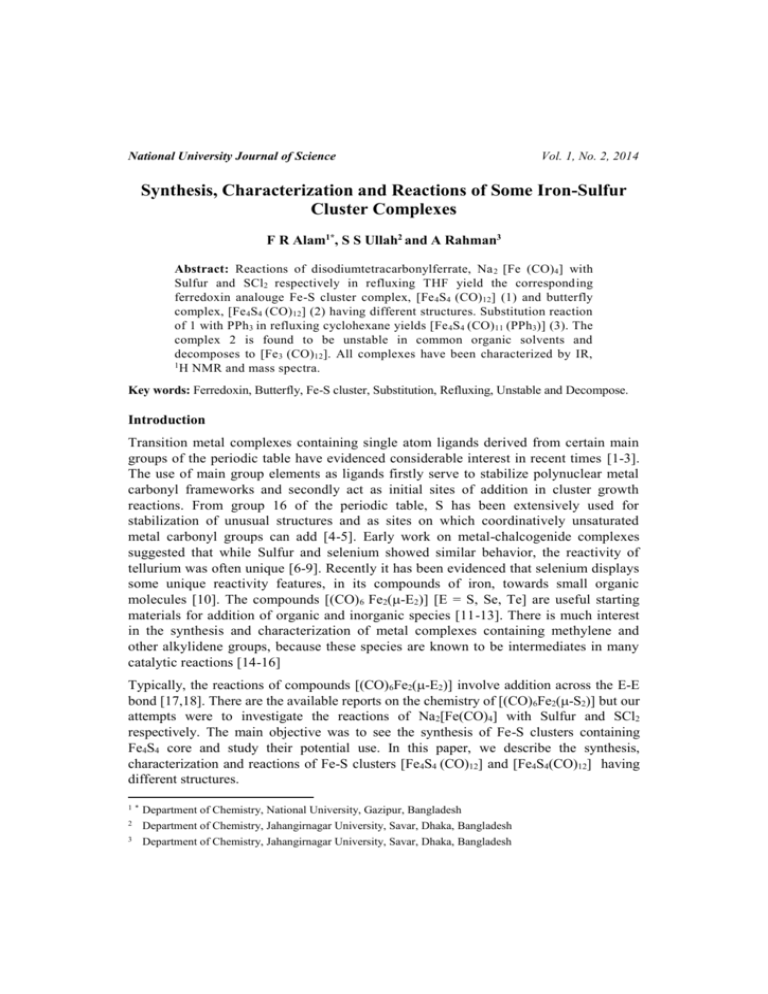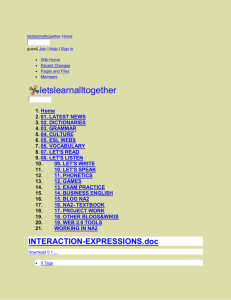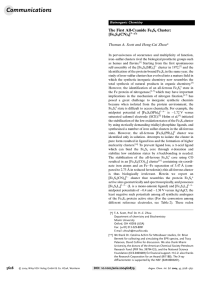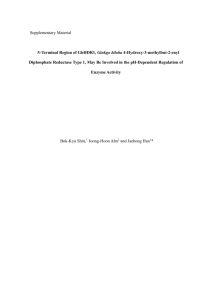06. Synthesis, Characterization
advertisement

National University Journal of Science
Vol. 1, No. 2, 2014
Synthesis, Characterization and Reactions of Some Iron-Sulfur
Cluster Complexes
F R Alam1*, S S Ullah2 and A Rahman3
Abstract: Reactions of disodiumtetracarbonylferrate, Na 2 [Fe (CO)4] with
Sulfur and SCl2 respectively in refluxing THF yield the corresponding
ferredoxin analouge Fe-S cluster complex, [Fe 4S4 (CO) 12] (1) and butterfly
complex, [Fe 4S4 (CO) 12] (2) having different structures. Substitution reaction
of 1 with PPh3 in refluxing cyclohexane yields [Fe 4S4 (CO) 11 (PPh3)] (3). The
complex 2 is found to be unstable in common organic solvents and
decomposes to [Fe 3 (CO)12]. All complexes have been characterized by IR,
1
H NMR and mass spectra.
Key words: Ferredoxin, Butterfly, Fe-S cluster, Substitution, Refluxing, Unstable and Decompose.
Introduction
Transition metal complexes containing single atom ligands derived from certain main
groups of the periodic table have evidenced considerable interest in recent times [1-3].
The use of main group elements as ligands firstly serve to stabilize polynuclear metal
carbonyl frameworks and secondly act as initial sites of addition in cluster growth
reactions. From group 16 of the periodic table, S has been extensively used for
stabilization of unusual structures and as sites on which coordinatively unsaturated
metal carbonyl groups can add [4-5]. Early work on metal-chalcogenide complexes
suggested that while Sulfur and selenium showed similar behavior, the reactivity of
tellurium was often unique [6-9]. Recently it has been evidenced that selenium displays
some unique reactivity features, in its compounds of iron, towards small organic
molecules [10]. The compounds [(CO) 6 Fe2(-E2)] [E = S, Se, Te] are useful starting
materials for addition of organic and inorganic species [11-13]. There is much interest
in the synthesis and characterization of metal complexes containing methylene and
other alkylidene groups, because these species are known to be intermediates in many
catalytic reactions [14-16]
Typically, the reactions of compounds [(CO)6Fe2(-E2)] involve addition across the E-E
bond [17,18]. There are the available reports on the chemistry of [(CO)6Fe2(-S2)] but our
attempts were to investigate the reactions of Na2[Fe(CO)4] with Sulfur and SCl2
respectively. The main objective was to see the synthesis of Fe-S clusters containing
Fe4S4 core and study their potential use. In this paper, we describe the synthesis,
characterization and reactions of Fe-S clusters [Fe4S4 (CO)12] and [Fe4S4(CO)12] having
different structures.
1*
2
3
Department of Chemistry, National University, Gazipur, Bangladesh
Department of Chemistry, Jahangirnagar University, Savar, Dhaka, Bangladesh
Department of Chemistry, Jahangirnagar University, Savar, Dhaka, Bangladesh
52
F R Alam, S S Ullah and A Rahman
Experimental
All reactions and subsequent work-up were carried out in dry nitrogen atmosphere. THF
was distilled under nitrogen from sodium benzophenone ketyl prior to use. Hydrocarbon
solvents were dried over sodium wire. Na2[Fe(CO)4][19] was prepared according to the
published method. Fe(CO)5, PPh3, S and SCl2 were used as received. IR spectra were
recorded on a Shimadzu 8010 spectrometer, 1H NMR spectra on a Bruker 500 MHz
spectrometer and mass spectra on a high resolution mass spectrometer.
Reaction of Na2[Fe(CO)4] with Sulfur
To a freshly prepared THF (40 mL) solution of Na2[Fe(CO)4] (1.09 g, 5.1mmol) was added
a solution of Sulfur (0.16 g, 0.64 mmol) in the same solvent under nitrogen atmosphere
with vigorous stirring at refluxing condition. After completion of addition, the reactants
were allowed to stir for 6 hours. The course of the reaction was monitored by analytical
TLC. The solvent was removed and the residue was extracted with petroleum ether (4060°C) and diethyl ether mixture (1:1, v/v) and filtered on kieselguhr. The filtrate was
concentrated and chromatographed over a column of silica gel (230-400 mesh) and eluted
with petroleum ether (40-60°C) to give a red band which on removal of solvent yielded
[Fe4S4(CO)12] (1) as ruby red crystals (0.39 g, 45%, m.p. 84-86°C). IR (cyclohexane, CO):
2083, 2062, 2042, 2006, 1990, 1965 and 1956 cm-1, MS : m/z 688 [M+], 604 [M+-3CO],
520 [M+-6CO], 436 [M+-9CO], 352 [M+-12CO], 324 [Fe3S4CO]+, 256 [Fe4S]+, 240
[Fe4S4]+, 152 [FeS3]+, 144 [Fe2S]+, 140 [Fe(CO)3]+, 120 [FeS2]+, 88 [FeS]+, 56 [Fe]+.
Reaction of Na2[Fe(CO)4] with SCl2
To a suspension of Na2[Fe(CO)4] (1.09 g, 5.1 mmol) in THF (40 mL) was added a
solution of SCl2 (0.525 g, 5.10 mmol) in the same solvent (30 mL) at room temperature
with stirring under nitrogen atmosphere. After completion of addition, the reaction
mixture was heated to reflux (66°C) for 6 hours. The progress of the reaction was
followed by analytical TLC. The solvent was then removed in vacuo and the residue
extracted with diethyl ether and filtered on kieselguhr. The filtrate was concentrated and
chromatographed over a column of silica gel (230-400 mesh). Elution with diethyl ether
gave a single red band. The band on removal of solvent yielded [Fe4S4(CO)12] (2) as dark
red crystals (0.57 g, 65%, m.p. 108-110°C). The complex is insoluble in nonpolar
hydrocarbon solvents i.e. n-pentane, n-hexane, cyclohexane, petroleum ether (40-60°C)
etc. IR (diethyl ether, CO): 2070, 2049, 2024, 2010, 2002, 1983 and 1966 cm-1 ; MS :
m/z 688 [M+], 660 [M+-CO], 548 [M+-5CO], 464 [M+-8CO], 408 [M+-10CO], 380 [M+11CO], 352 [M+-12CO], 288 [Fe4S2]+, 232 [Fe3S2]+, 176 [Fe2S2]+, 152 [FeS3]+, 144
[Fe2S]+, 140 [Fe(CO)3]+, 128 [S4]+, 120 [FeS2]+, 88 [FeS]+, 64 [S2]+ and 56 [Fe]+.
Reaction of [Fe4S4(CO)12] (1) with PPh3
A hexane solution (30 mL) of [Fe4S4(CO)12] (0.10 g, 0.145 mmol) and PPh3 (0.038 g,
0.145 mmol) heated to reflux for 12 hours during which it was changed from red to light
brown. Solvent was then removed and the reaction mass was chromatographed over a
column of silica gel (230-400 mesh). Elution with pet. ether (40-60°C) gave a reddishbrown band. The band on removal of solvent afforded [Fe4S4(CO)11(PPh3)] (3) as reddishbrown crystals (0.064 g, 48%, m.p. 101-102°C); IR (cyclohexane, CO): 2071, 2052,
Synthesis, Characterization and Reactions of Some Iron-Sulfur Cluster Complexes
53
2031, 2004, 1983, 1960, 1946 and 1923 cm-1 ; 1H NMR (CDCl3) : 7.6-7.39 (m, 15H);
MS : m/z 922 [M+ not observed], 660 [M+-P(C6H5)3], 632 [M+-{P(C6H5)3 + CO}], 604
[M+-{P(C6H5)3 + 2CO}], 548 [M+-{P(C6H5)3 + 4CO}], 464 [M+-{P(C6H5)3 + 7CO}], 436
[M+-{P(C6H5)3 + 8CO}], 408 [M+-{P(C6H5)3 + 9CO}], [M+-{P(C6H5)3 + CO}], 380
[M+-{P(C6H5)3 + 10CO}], 352 [M+-{P(C6H5)3 + 11CO}], 296 [Fe3S4]+, 264 [Fe3S3]+, 232
[Fe3S2]+, 200 [Fe3S]+, 88 [FeS]+, 56 [Fe]+, 262 [P(C6H5)3]+, 185 [P(C6H5)2]+, 108
[P(C6H5)]+, 31 [P]+.
Decomposition reaction of [Fe4S4(CO)12] (2) into [Fe3(CO)12] and elemental Sulfur
The iron-Sulfur cluster [Fe4S4(CO)12] is insoluble in most of the common organic
solvents like n-pentane, n-hexane, petroleum ether (40-60°C), cyclohexane etc; in which
cluster 2 decomposed rapidly (about 5-10 minutes) into [Fe3(CO)12] and Sulfur.
[Fe3(CO)12] remains as green solution while Sulfur precipitates as yellow solid (m.p. 112114°C). In diethyl ether, the cluster 2 also decomposed but slowly (about 22 hours), in a
similar manner to give Fe3(CO)12 solution and solid component.
Results and Discusion
The reaction of Na2[Fe(CO)4] with elemental Sulfur in THF at refluxing condition under
nitrogen atmosphere for 6 hours resulted in the isolation of [Fe4S4(CO)12] (1) as rubyred
crystals in 45% yield. The IR spectrum of 1 in cyclohexane exhibited CO bands at 2083,
2062, 2042, 2006, 1990, 1965 and 1956 cm-1. These bands are regarded as terminal CO
stretching frequencies (1800-2140 cm-1) [20]. The significant upward shifts in vibrational
frequencies [from 1790 cm-1 for Na2[Fe(CO)4][21] clearly indicates the formation of
neutral complex. These spectral pattern are also characteristics of the cluster complex
with terminal carbonyls. Moreover, the carbonyl absorption of 1 are similar to those
observed for Fe-S cluster complex [Fe4(HSCH2CH2SH)2(CO)12] [22].
The mass spectrum of 1 showed the molecular ion peak M+ at m/z 688 corresponding to
molecular formula [Fe4S4(CO)12]. Other important peaks at 604, 520, 436, 352 are due to
the sequential loss of three, six, nine and twelve CO groups from molecular ion peak
(M+). The mass fragmentation pattern of the complex 1 may be represented schematically
as follows (Scheme 1) is in agreement with the proposed formula for [Fe4S4(CO)12].
Thus on the basis of the spectral evidences the structure of the compound is proposed as
1, shown in scheme I.
OC COCO
Fe
S
CO
S
Fe
CO
CO
Na2[Fe(CO)4] + S8
THF
6hrs, reflux
S
Fe
OC Fe
OC CO
S
(1)
Scheme I
CO
CO
CO
54
F R Alam, S S Ullah and A Rahman
The reaction of Na2[Fe(CO)4] with SCl2 in refluxing THF under nitrogen atmosphere for
6 hours resulted [Fe4S4(CO)12] (2) as dark red crystalline complex in 65% yield. The IR
spectrum of 2 in diethyl ether exhibited CO bands at 2070, 2049, 2024, 2010, 2002,
1983 and 1966 cm-1. These bands are regarded as terminal carbonyl stretching
frequencies.20 The significant upward shifts in vibrational frequencies [from 1790 cm-1
for Na2[Fe(CO)4]21 is a clear indication of the formation of a neutral complex. The IR
spectral pattern is also characteristics of the cluster complex with terminal carbonyl
groups. The CO frequencies are similar to those reported for cluster complex.22
The mass spectrum of 2 showed the molecular ion peak at m/z 688, corresponding to the
molecular formula [Fe4S4(CO)12]. Other important peaks at 660, 548, 464, 408, 380 and
352 are due to the successive loss of one, five, eight, ten, eleven and twelve CO groups
from M+. The mass fragmentation pattern is in agreement with proposed complex 2.
Thus on the basis of the spectral evidences the structure of the compound is proposed as
2, shown in scheme II.
S
Na2[Fe(CO)4] + SCl2
THF
6hrs, reflux
OC
OC Fe
OC
S
S
S
Fe
OC
Scheme II
CO
CO
Fe CO
CO
Fe
CO
OC
CO
CO
(2)
The reaction of [Fe4S4(CO)12] (2) with PPh3 (1:1 molar ratio) in refluxing cyclohexane for
12 hours under nitrogen atmosphere gave a reddish-brown solution. Usual work up of the
reaction mass and chromatographic separation as detailed in the experimental section
resulted in the isolation of reddish-brown crystals of [Fe4S4(CO)11(PPh3)] (3) in 48%
yield. The complex has been characterized by IR, 1H NMR and mass spectroscopic data.
The IR spectrum of 3 in CDCl3 exhibited bands at 2071, 2052, 2031, 1983, 1960, 1946
and 1923 cm-1 in terminal carbonyl stretching region20. The drop in CO frequencies
[from 2083, 2062, 2042, 2006, 1990, 1965 cm-1 for [Fe4S4(CO)12] to 2071, 2052, 2031,
2004, 1983, 1960, 1946 and 1923 cm-1 confirm the formation of a new complex. The
shifting of CO frequencies to lower values can be accounted for by the fact that the
ligand PPh3 is a -donor and has essentially no ability to back accept and hence increase
the M-C bond orders and shifts the remaining CO frequencies to lower values.
The 1H NMR spectrum of 3 in CDCl3 exhibited signals at 7.6-7.39 as a multiplet. The
multiplet at 7.6-7.39 is due to aromatic protons of PPh3. The multiplet at 7.6-7.39
clearly indicates the formation of new complex, in which PPh3 unit is attached to the Fe
atom by direct substitution of one CO group.
Synthesis, Characterization and Reactions of Some Iron-Sulfur Cluster Complexes
55
Based on the proposed molecular formula the mass spectrum is expected to exhibit
molecular ion (M+) peak at m/z 922. But loss of some part of the complex is energetically
most facile and therefore no parent molecular ion (M+) peak is observed. The highest peak
observed at m/z 660 is due to loss of PPh3 from the parent molecular ion peak [m/z 922].
The mass fragmentation pattern is in agreement with the proposed molecular formula.
Thus on the basis of the spectral evidences the structure of the compound is proposed as
3, shown in scheme III.
OC COC O
Fe
S
CO
S
P P h3
Fe
CO
[F e4S 4(C O )12] + P P h3
( 1)
cyclohexane
CO
Fe C O
CO
S
12 hrs, reflux
OC Fe
OC C O
S
( )
Scheme III
The iron-Sulfur cluster [Fe4S4(CO)12] (2) is insoluble in most of the common organic
solvents like n-pentane, n-hexane, petroleum ether (40-60°C), cyclohexane etc. However,
in the above mentioned solvents, cluster 2 decomposed rapidly giving [Fe3(CO)12] as
green solution and elemental Sulfur as yellow precipitate. Cluster 2 also decomposed in
diethyl ether, but slowly, in a similar manner to give [Fe3(CO)12] solution and elemental
Sulfur. [Fe3(CO)12] has been characterized by IR and elemental Sulfur has been identified
by lead acetate and sodium nitropruside test.
Characterization of Fe3(CO)12
The IR spectrum of the green solution exhibited CO bands at 2047, 2025, 1997, 1867
and 1835 cm-1, which are similar to those of an authentic sample of [Fe3(CO)12] (CO,
2046, 2023, 1867 and 1835 cm-1).26
Identification of the solid component
Elemental Sulfur has been identified using the sodium fusion solution of yellow residue
with lead acetate and sodium nitropruside solution saperately by the following methods.
1. 1 mL of the fusion solution was acidified with dilute acetic acid and was added a few
drops of lead acetate solution. A black precipitate of lead sulphide indicated the presence
of Sulfur.
56
F R Alam, S S Ullah and A Rahman
2. To 1 mL of the fusion solution was added 2-3 drops of a freshly prepared dilute
solution (0.1%) disodiumpentacyanonitrosylferrate, Na2[Fe(CN)5NO]. Formation of a
purple colouration which fades on standing indicated the presence of Sulfur.
Thus on the basis of IR and the above chemical tests with lead acetate and sodium
nitropruside, it is evident that [Fe3(CO)12] and Sulfur were formed by the decomposition
of cluster [Fe4S4(CO)12] (2) as shown in scheme IV.
[F e4S 4( C O ) 12]
( 2)
RT
solvent
[F e3( C O ) 12]
+ S
solvent = n-pentane, n-hexane
Scheme IV
pet. ether (40-60°C)
diethyl ether
Conclusion
We have described the systhesis of Fe-S cluster complexes 1 and 2 having different
structures from the reactions of Na2[Fe(CO)4] with elemental Sulfur and SCl2
respectively. Complex 1 having ferredoxin analouge structure is found to be stable, while
complex 2 having butterfly structure is found to be unstable. Complex 3, the derivative of
complex 1 is also found to be stable. Electron counts shows that all of them satisfy the 18
eletron rule. Work in this respect is in progress and will be reported elsewhere.
Acknowledgement
The authors are thankful to the Department of Chemistry, Jahangirnagar University for
technical support.
References
1.
Whitemire K. H., 1988, J. Coord. Chem. 17, 95.
2.
Linford L. and Raubenheimer H. G., 1991, Adv. Organomet. Chem. 32, 1.
3.
Compton N. A., Errington R. J. and Norman N. C., 1990, Adv. Organomet. Chem. 31, 91 .
4.
Adams R. D., 1985, Polyhedron, 4, 2003.
5.
Adams R. D. and Horvath I. T., 1985, Prog. Inorg. Chem. 33, 127.
6.
Bogan L. E., Clark G. R. and Rauchfuss T. B., 1986, Inorg. Chem. 25, 4050.
7.
Adams R. D., Babin J. E. and Tasi M., 1987, Inorg. Chem. 26, 2807.
8.
Mathur P., Mavunkal I. J. and Rugmini V., 1989, J. Organomet. Chem. 367, 243.
9.
Mathur P., Chakrabarty D. and Mavunkal I. J., 1993, J. Cluster Sci. 4, 351.
10. Mathur P. and Hossain M. M., 1993, Organometallics, 12, 2398.
11. Seyferth D. and Womack G. B., 1986, Organometallics, 5, 2360.
Synthesis, Characterization and Reactions of Some Iron-Sulfur Cluster Complexes
57
12. Seyferth D., Womack G. B., Henderson R. S., Cowie M. and Hames B. M., 1986, Organometallics, 5, 1568.
13. Seyferth D., Henderson R. S., Song L. C. and Womack G. B.,1985, J. Organomet. Chem. 292, 9.
14. Garcia M. E., Tran-Huy N. H., Jeffrey J. C., Sherwood
J. Chem. Soc. Dalton Trans. 2201.
P. and Stone F. G. A.,
15. Brady R. C. and Pettit R., 1980, J. Am. Chem. Soc. 102, 6181.
16. Grubbs R. H., 1978, Progr. Inorg. Chem. 24, 1.
17. Shaver A., Fitz Patrick P. J., Stehom K. and Butler L. S., 1979, J. Am. Chem. Soc. 101, 1313.
18. Mathur P., Reddy V. D. and Bohra R., 1991, J. Organomet. Chem. 401, 339.
19. Collman J. P., 1975, Ace. Chem. Res. 8, 342.
20. Bullitt J. G., Cotton F. A. and Marks T. J., 1969, Inorg. Chem. 11, 671.
21. Farmey K., Kilmer M., Greatrex R. and Greenwood N. N., 1969, J. Chem. Soc. 2339.
22. Ullah S. S., Alam F. R., Ishizuka Y. and Goto M., 1996, Indian J. Chem. 35A, 930.
22. Kinght J. and Mays M. J., 1970, Chem.Commun. 1006.
1987,








![Initial synthesis and structure of an all-ferrous S ]](http://s2.studylib.net/store/data/013216586_1-a68ba259749e2a63c905b480d5cfe664-300x300.png)